Deck 1: The Electric Field I: Discrete Charge Distributions
Question
Question
Question
Question
Question
Question
Question
Question
Question
Question
Question
Question
Question
Question
Question
Question
Question
Question
Question
Question
Question
Question
Question
Question
Question
Question
Question
Question
Question
Question
Question
Question
Question
Question
Question
Question
Question
Question
Question
Question
Question
Question
Question
Question
Question
Question
Question
Question
Question
Question
Question
Question
Question
Question
Question
Question
Question
Question
Question
Question
Question
Question
Question
Question
Question
Question
Question
Question
Question
Question
Question
Question
Question
Question
Question
Question
Question
Question
Question
Question

Unlock Deck
Sign up to unlock the cards in this deck!
Unlock Deck
Unlock Deck
1/87
Play
Full screen (f)
Deck 1: The Electric Field I: Discrete Charge Distributions
1
Two small spheres repel one another electrostatically. Which of the following statements must be true?
A) both have the same charge
B) neither is charged
C) both are charged
D) at least one sphere is charged
E) they are oppositely charged
A) both have the same charge
B) neither is charged
C) both are charged
D) at least one sphere is charged
E) they are oppositely charged
both have the same charge
2
 A uniformly positively charged spherical conductor is placed midway between two identical uncharged conducting spheres. How would the charges in the middle sphere be distributed?
A uniformly positively charged spherical conductor is placed midway between two identical uncharged conducting spheres. How would the charges in the middle sphere be distributed?A) The positive charges stay uniformly distributed on the surface of the middle sphere.
B) There are more positive charges near the top and bottom of the sphere compared to the sides next to the two other spheres.
C) There are more positive charges near the sides of the spheres that are next to the other two spheres compared to the other regions of the sphere.
D) There are more positive charges near the front and back of the sphere compared to the sides next to the two other spheres.
E) None of these is correct.
There are more positive charges near the sides of the spheres that are next to the other two spheres compared to the other regions of the sphere.
3
A positive charge of 63.0 nC is 15.0 cm from a negative charge of 45.0 nC. The force on one of the charges due to the other is approximately
A) 1.13 * 10-3 N
B) 1.13 *10-7 N
C) 1.02 *107 N
D) 1.25 *10-13 N
E) 1.02* 10-6 N
A) 1.13 * 10-3 N
B) 1.13 *10-7 N
C) 1.02 *107 N
D) 1.25 *10-13 N
E) 1.02* 10-6 N
1.13 * 10-3 N
4
Protons
A) are about 2000 times more massive than electrons.
B) are about 2000 times less massive than electrons.
C) have 2000 times the charge of electrons.
D) have 1/2000 the charge of electrons.
E) can have any amount of charge.
A) are about 2000 times more massive than electrons.
B) are about 2000 times less massive than electrons.
C) have 2000 times the charge of electrons.
D) have 1/2000 the charge of electrons.
E) can have any amount of charge.

Unlock Deck
Unlock for access to all 87 flashcards in this deck.
Unlock Deck
k this deck
5
How many electrons must be transferred to a body to produce a charge of 125 nC?
A) 1.25 * 10-7
B) 1.60 * 10-19
C) 1.28 * 1012
D) 3.45 * 1011
E) 7.81 * 1011
A) 1.25 * 10-7
B) 1.60 * 10-19
C) 1.28 * 1012
D) 3.45 * 1011
E) 7.81 * 1011

Unlock Deck
Unlock for access to all 87 flashcards in this deck.
Unlock Deck
k this deck
6
 If you bring a positively charged insulator near two uncharged metallic spheres that are in contact and then separate the spheres, the sphere on the right will have
If you bring a positively charged insulator near two uncharged metallic spheres that are in contact and then separate the spheres, the sphere on the right will haveA) no net charge.
B) a positive charge.
C) a negative charge.
D) either a positive or negative charge.
E) None of these is correct.

Unlock Deck
Unlock for access to all 87 flashcards in this deck.
Unlock Deck
k this deck
7
Two small spheres attract one another electrostatically. This can occur for a variety of reasons. Which of the following statements must be true?
A) at least one sphere is charged
B) neither is charged
C) both are charged
D) both have the same charge
E) None of these is correct.
A) at least one sphere is charged
B) neither is charged
C) both are charged
D) both have the same charge
E) None of these is correct.

Unlock Deck
Unlock for access to all 87 flashcards in this deck.
Unlock Deck
k this deck
8
A positive charge of 94.0 nC is 12.0 cm from a negative charge of 53.0 nC. The force on one of the charges due to the other is approximately
A) 1.13 mN
B) 0.373 mN
C) 3.11 mN
D) 1.25 mN
E) 1.02 N
A) 1.13 mN
B) 0.373 mN
C) 3.11 mN
D) 1.25 mN
E) 1.02 N

Unlock Deck
Unlock for access to all 87 flashcards in this deck.
Unlock Deck
k this deck
9
Electric charges of the same sign
A) also have the same magnitude.
B) attract each other.
C) repel each other.
D) exert no forces on each other.
E) None of these is correct.
A) also have the same magnitude.
B) attract each other.
C) repel each other.
D) exert no forces on each other.
E) None of these is correct.

Unlock Deck
Unlock for access to all 87 flashcards in this deck.
Unlock Deck
k this deck
10
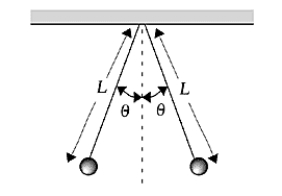 Two small spheres, each with mass m = 5.0 g and charge q, are suspended from a point by threads of length L = 0.30 m. What is the charge on each sphere if the threads make an angle = 20º with the vertical?
Two small spheres, each with mass m = 5.0 g and charge q, are suspended from a point by threads of length L = 0.30 m. What is the charge on each sphere if the threads make an angle = 20º with the vertical?A) 7.9 * 10-7 C
B) 2.9 * 10-7 C
C) 7.5 * 10-2 C
D) 6.3 *10-13 C
E) 1.8 *10-7 C

Unlock Deck
Unlock for access to all 87 flashcards in this deck.
Unlock Deck
k this deck
11
Electric charges of the opposite sign
A) also have the same magnitude.
B) attract each other.
C) exert no forces on each other.
D) repel each other.
E) None of these is correct.
A) also have the same magnitude.
B) attract each other.
C) exert no forces on each other.
D) repel each other.
E) None of these is correct.

Unlock Deck
Unlock for access to all 87 flashcards in this deck.
Unlock Deck
k this deck
12
Electrons
A) are about 2000 times more massive than protons.
B) are about 2000 times less massive than protons.
C) have 2000 times the charge of protons.
D) have 1/2000 the charge of protons.
E) can have any amount of charge.
A) are about 2000 times more massive than protons.
B) are about 2000 times less massive than protons.
C) have 2000 times the charge of protons.
D) have 1/2000 the charge of protons.
E) can have any amount of charge.

Unlock Deck
Unlock for access to all 87 flashcards in this deck.
Unlock Deck
k this deck
13
Experimental evidence indicates that
A) charge is quantized and conserved.
B) charge is quantized but not conserved.
C) charge is conserved but not quantized.
D) charge is neither quantized nor conserved.
E) None of these answers is correct.
A) charge is quantized and conserved.
B) charge is quantized but not conserved.
C) charge is conserved but not quantized.
D) charge is neither quantized nor conserved.
E) None of these answers is correct.

Unlock Deck
Unlock for access to all 87 flashcards in this deck.
Unlock Deck
k this deck
14
Which of the following statements about conductors and insulators is NOT correct?
A) Charges can move freely in conductors.
B) Charges can move freely in insulators.
C) In conductors, one or more of the outer electrons from an atom is no longer bounded to the atom.
D) In insulators, all the electrons from an atom are bounded to the atom.
E) Charges in both conductors and insulators can become polarized, i.e., one end has charges of one sign and the other end has charges of opposite sign.
A) Charges can move freely in conductors.
B) Charges can move freely in insulators.
C) In conductors, one or more of the outer electrons from an atom is no longer bounded to the atom.
D) In insulators, all the electrons from an atom are bounded to the atom.
E) Charges in both conductors and insulators can become polarized, i.e., one end has charges of one sign and the other end has charges of opposite sign.

Unlock Deck
Unlock for access to all 87 flashcards in this deck.
Unlock Deck
k this deck
15
If an object is determined to have a negative charge of 160 nC, you can conclude that the object has an excess of
A) 109 electrons
B) 1010 electrons
C) 1011 electrons
D) 1012 electrons
E) 1013 electrons
A) 109 electrons
B) 1010 electrons
C) 1011 electrons
D) 1012 electrons
E) 1013 electrons

Unlock Deck
Unlock for access to all 87 flashcards in this deck.
Unlock Deck
k this deck
16
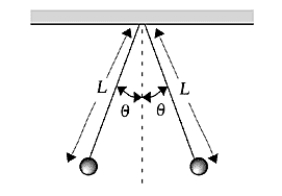 Two small spheres, each with mass m = 3.0 g and charge q, are suspended from a point by threads of length L = 0.22 m. What is the charge on each sphere if the threads make an angle = 15º with the vertical?
Two small spheres, each with mass m = 3.0 g and charge q, are suspended from a point by threads of length L = 0.22 m. What is the charge on each sphere if the threads make an angle = 15º with the vertical?A) 0.79 C
B) 2.9 C
C) 75 mC
D) 6.3 C
E) 0.11 C

Unlock Deck
Unlock for access to all 87 flashcards in this deck.
Unlock Deck
k this deck
17
A particular nucleus of the element erbium contains 68 protons and 90 neutrons. What is the total number of electrons in the neutral erbium atom?
A) 90
B) 158
C) 22
D) 68
E) None of the above
A) 90
B) 158
C) 22
D) 68
E) None of the above

Unlock Deck
Unlock for access to all 87 flashcards in this deck.
Unlock Deck
k this deck
18
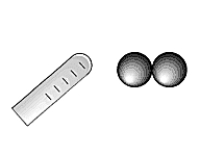 If you bring a negatively charged insulator near two uncharged metallic spheres that are in contact and then separate the spheres, the sphere on the right will have
If you bring a negatively charged insulator near two uncharged metallic spheres that are in contact and then separate the spheres, the sphere on the right will haveA) no net charge.
B) a positive charge.
C) a negative charge.
D) either a positive or negative charge.
E) None of these is correct.

Unlock Deck
Unlock for access to all 87 flashcards in this deck.
Unlock Deck
k this deck
19
An electron (q = +e) and a positron (q = +e) can combine to give off two gamma rays. The net change in the algebraic sum of the charges is
A) +2e
B) zero
C) -2e
D) +e
E) -e
A) +2e
B) zero
C) -2e
D) +e
E) -e

Unlock Deck
Unlock for access to all 87 flashcards in this deck.
Unlock Deck
k this deck
20
A particular nucleus of the element erbium contains 68 protons and 90 neutrons. What is the total charge of the erbium nucleus?
A) zero
B) 1.4 *10-17 C
C) 2.5*10-17 C
D) 1.1* 10-17 C
E) 3.5 * 10-18 C
A) zero
B) 1.4 *10-17 C
C) 2.5*10-17 C
D) 1.1* 10-17 C
E) 3.5 * 10-18 C

Unlock Deck
Unlock for access to all 87 flashcards in this deck.
Unlock Deck
k this deck
21
The Coulomb's force between a proton and an electron is 2.27*1039 times greater than the gravitational force. If the two forces were equal, what should the size of the elementary charge be
A) 1.60 * 10-19 C
B) 3.36 * 10-39 C
C) 1.23 * 10-77 C
D) 2.27 * 10-39 C
E) 4.41 * 10-40 C
A) 1.60 * 10-19 C
B) 3.36 * 10-39 C
C) 1.23 * 10-77 C
D) 2.27 * 10-39 C
E) 4.41 * 10-40 C

Unlock Deck
Unlock for access to all 87 flashcards in this deck.
Unlock Deck
k this deck
22
Charges q1 and q2 exert repulsive forces of 10 N on each other. What is the repulsive force when their separation is decreased so that their final separation is 80% of their initial separation?
A) 16 N
B) 12 N
C) 10 N
D) 8.0 N
E) 6.4 N
A) 16 N
B) 12 N
C) 10 N
D) 8.0 N
E) 6.4 N

Unlock Deck
Unlock for access to all 87 flashcards in this deck.
Unlock Deck
k this deck
23
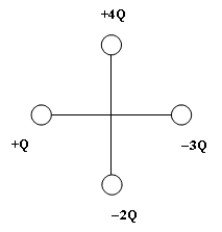 If all the charges are 15 cm from the origin (the crossing point of the vertical and horizontal lines) in the above figure and Q = +3.0 C, then calculate the magnitude of the net force on a charge of +Q placed at the origin.
If all the charges are 15 cm from the origin (the crossing point of the vertical and horizontal lines) in the above figure and Q = +3.0 C, then calculate the magnitude of the net force on a charge of +Q placed at the origin.A) 22.8 N
B) 10.2 N
C) 26.0 N
D) 187 N
E) none of the above

Unlock Deck
Unlock for access to all 87 flashcards in this deck.
Unlock Deck
k this deck
24
Three charges are located at 100-m intervals along a horizontal line: a charge of -3.0 C on the left, +2.0 C in the middle, and +1.0 C on the right. What is the resultant force on the 1.0 C charge due to the other two?
A) 1.1 * 106 N to the right
B) 1.1 * 106 N to the left
C) 2.5 *106 N to the right
D) 2.5 *106 N to the left
E) 4.5*107 N to the right
A) 1.1 * 106 N to the right
B) 1.1 * 106 N to the left
C) 2.5 *106 N to the right
D) 2.5 *106 N to the left
E) 4.5*107 N to the right

Unlock Deck
Unlock for access to all 87 flashcards in this deck.
Unlock Deck
k this deck
25
An electron is moving horizontally east in an electric field that points vertically upward. The electric force on the proton is
A) zero.
B) upward.
C) downward.
D) to the west.
E) to the east.
A) zero.
B) upward.
C) downward.
D) to the west.
E) to the east.

Unlock Deck
Unlock for access to all 87 flashcards in this deck.
Unlock Deck
k this deck
26
A proton is about 2000 times more massive that an electron but they both have charges of the same magnitude. The magnitude of the force on an electron by a proton is ____ the magnitude of the force on the proton by the electron.
A) 2000 times greater than
B) equal to
C) 2000 times less than
D) negligible compared to
E) None of these answers is correct.
A) 2000 times greater than
B) equal to
C) 2000 times less than
D) negligible compared to
E) None of these answers is correct.

Unlock Deck
Unlock for access to all 87 flashcards in this deck.
Unlock Deck
k this deck
27
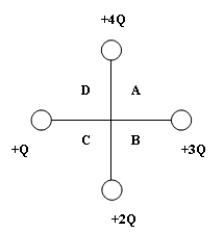 If a charge of +2Q were placed at the origin (the crossing point of the vertical and horizontal lines) of the above figure, into which quadrant would it feel a net force?
If a charge of +2Q were placed at the origin (the crossing point of the vertical and horizontal lines) of the above figure, into which quadrant would it feel a net force?A) A
B) B
C) C
D) D
E) None, it feels no net force.

Unlock Deck
Unlock for access to all 87 flashcards in this deck.
Unlock Deck
k this deck
28
The force between two very small charged bodies is found to be F. If the distance between them is doubled without altering their charges, the force between them becomes
A) F/2
B) 2F
C) F/4
D) 4F
E) 1/F2
A) F/2
B) 2F
C) F/4
D) 4F
E) 1/F2

Unlock Deck
Unlock for access to all 87 flashcards in this deck.
Unlock Deck
k this deck
29
The force between two very small charged bodies is found to be F. If the distance between them is tripled without altering their charges, the force between them becomes
A) 9F
B) 3F
C) F/3
D) F/9
E) 1/F3
A) 9F
B) 3F
C) F/3
D) F/9
E) 1/F3

Unlock Deck
Unlock for access to all 87 flashcards in this deck.
Unlock Deck
k this deck
30
A proton is moving horizontally north in an electric field that points vertically upward. The electric force on the proton is
A) zero.
B) upward.
C) downward.
D) to the west.
E) to the east.
A) zero.
B) upward.
C) downward.
D) to the west.
E) to the east.

Unlock Deck
Unlock for access to all 87 flashcards in this deck.
Unlock Deck
k this deck
31
Coulomb's law and Newton's law of gravitation both involve which of the following?
A) the mass of the particle
B) the charge on the particle
C) permeability
D) permittivity
E) the inverse-square law
A) the mass of the particle
B) the charge on the particle
C) permeability
D) permittivity
E) the inverse-square law

Unlock Deck
Unlock for access to all 87 flashcards in this deck.
Unlock Deck
k this deck
32
Two positive charges (+8.0 mC and +2.0 mC) are separated by 300 m. A third charge is placed at distance r from the +8.0 mC charge in such a way that the resultant electric force on the third charge due to the other two charges is zero. The distance r is
A) 0.25 km
B) 0.20 km
C) 0.15 km
D) 0.13 km
E) 0.10 km
A) 0.25 km
B) 0.20 km
C) 0.15 km
D) 0.13 km
E) 0.10 km

Unlock Deck
Unlock for access to all 87 flashcards in this deck.
Unlock Deck
k this deck
33
Which of the following statements is not true?
A) In nature, electric charge is conserved.
B) The force of repulsion between two like charges is directly proportional to the product of the square of the charges.
C) The force of repulsion between two like charges is inversely proportional to the square of the distance separating the charges.
D) Unlike charges attract each other.
E) Like charges repel each other.
A) In nature, electric charge is conserved.
B) The force of repulsion between two like charges is directly proportional to the product of the square of the charges.
C) The force of repulsion between two like charges is inversely proportional to the square of the distance separating the charges.
D) Unlike charges attract each other.
E) Like charges repel each other.

Unlock Deck
Unlock for access to all 87 flashcards in this deck.
Unlock Deck
k this deck
34
 If a charge of +2Q were placed at the origin (the crossing point of the vertical and horizontal lines) of the above figure, into which quadrant would it feel a net force?
If a charge of +2Q were placed at the origin (the crossing point of the vertical and horizontal lines) of the above figure, into which quadrant would it feel a net force?A) A
B) B
C) C
D) D
E) None, it feels no net force.

Unlock Deck
Unlock for access to all 87 flashcards in this deck.
Unlock Deck
k this deck
35
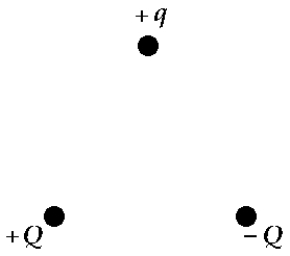 Three charges +q, +Q, and -Q are placed at the corners of an equilateral triangle as shown. The net force on charge +q due to the other two charges is
Three charges +q, +Q, and -Q are placed at the corners of an equilateral triangle as shown. The net force on charge +q due to the other two charges isA) vertically up.
B) vertically down.
C) zero.
D) horizontal to the left.
E) horizontal to the right.

Unlock Deck
Unlock for access to all 87 flashcards in this deck.
Unlock Deck
k this deck
36
Point charges of 4.0 *10-8 C and -2.0 * 10-8 C are placed 12 cm apart. A third point charge of 3.0 *10-8 C halfway between the first two point charges experiences a force of magnitude
A) 4.5 *10-3 N
B) 2.0 * 10-3 N
C) 1.5*10-3 N
D) zero
E) 5.0 * 10-3 N
A) 4.5 *10-3 N
B) 2.0 * 10-3 N
C) 1.5*10-3 N
D) zero
E) 5.0 * 10-3 N

Unlock Deck
Unlock for access to all 87 flashcards in this deck.
Unlock Deck
k this deck
37
 A charge 2Q is located at the origin while a second charge -Q is located at x = a. Where should a third charge be placed so that the net force on the charge is zero?
A charge 2Q is located at the origin while a second charge -Q is located at x = a. Where should a third charge be placed so that the net force on the charge is zero?A) x < 0
B) 0 < x < a
C) x > a
D) x < 0 or 0 < x < a
E) 0 < x < a or x > a

Unlock Deck
Unlock for access to all 87 flashcards in this deck.
Unlock Deck
k this deck
38
Two electrons are separated by a distance of 1.6 nm. Each experiences an electrostatic force of approximately
A) 9.0 * 109 N
B) 1.1 * 10-32 N
C) 9.0 * 1020 N
D) 1.0 * 10-22 N
E) 9.0 *10-11 N
A) 9.0 * 109 N
B) 1.1 * 10-32 N
C) 9.0 * 1020 N
D) 1.0 * 10-22 N
E) 9.0 *10-11 N

Unlock Deck
Unlock for access to all 87 flashcards in this deck.
Unlock Deck
k this deck
39
Charges q1 and q2 exert repulsive forces of 15 N on each other. What is the repulsive force when their separation is increased so that their final separation is 160% of their initial separation?
A) 1.3 N
B) 5.9 N
C) 9.8 N
D) 8.7 N
E) 6.4 N
A) 1.3 N
B) 5.9 N
C) 9.8 N
D) 8.7 N
E) 6.4 N

Unlock Deck
Unlock for access to all 87 flashcards in this deck.
Unlock Deck
k this deck
40
A particular nucleus of the element plutonium contains 94 protons and 150 neutrons. What is the magnitude of the force from the nucleus on a single electron that is at a distance of 0.563 * 10-12 m from the plutonium nucleus?
A) 4.27 * 1015 N
B) 3.85 * 10-14 N
C) 6.83 * 10-2 N
D) 6.42 N
E) 1.09 * 10-1 N
A) 4.27 * 1015 N
B) 3.85 * 10-14 N
C) 6.83 * 10-2 N
D) 6.42 N
E) 1.09 * 10-1 N

Unlock Deck
Unlock for access to all 87 flashcards in this deck.
Unlock Deck
k this deck
41
Two charges Q1 and Q2 are a distance d apart. If the electric field is zero at a distance of 3d/4 from Q1 (towards Q2), then what is the relation between Q1 and Q2?
A) Q1 = Q2 /9
B) Q1 = 9Q2
C) Q1 = Q2 /3
D) Q1 = 3Q2
E) Q1 = 4Q2 /3
A) Q1 = Q2 /9
B) Q1 = 9Q2
C) Q1 = Q2 /3
D) Q1 = 3Q2
E) Q1 = 4Q2 /3

Unlock Deck
Unlock for access to all 87 flashcards in this deck.
Unlock Deck
k this deck
42
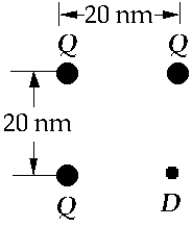 Three charges, each of Q = 3.2 *10-19 C, are arranged at three of the corners of a 20-nm square as shown. The magnitude of the electric field at D, the fourth corner of the square, is approximately
Three charges, each of Q = 3.2 *10-19 C, are arranged at three of the corners of a 20-nm square as shown. The magnitude of the electric field at D, the fourth corner of the square, is approximatelyA) 1.4 * 107 N/C
B) 1.0 * 1011 N/C
C) 3.6 *1010 N/C
D) 30 N/C
E) 1.8* 107 N/C

Unlock Deck
Unlock for access to all 87 flashcards in this deck.
Unlock Deck
k this deck
43
 Three positive and equal charges Q1, Q2, and Q3 are at the corners of an equilateral triangle as shown. Point P is at the midpoint of the line between Q1 and Q3. The electric field at P is
Three positive and equal charges Q1, Q2, and Q3 are at the corners of an equilateral triangle as shown. Point P is at the midpoint of the line between Q1 and Q3. The electric field at P isA) zero.
B) not zero and is directed along the line from P to Q3.
C) not zero and is directed along the line from P to Q2.
D) not zero and is directed along the line from Q1 to Q2.
E) None of these is correct.

Unlock Deck
Unlock for access to all 87 flashcards in this deck.
Unlock Deck
k this deck
44
A positive charge that is in an electric field  experiences a force that is
experiences a force that is
A) perpendicular to .
.
B) zero because the speed is zero.
C) in the direction opposite to .
.
D) in the same direction as .
.
E) None of these is correct.
 experiences a force that is
experiences a force that isA) perpendicular to
 .
.B) zero because the speed is zero.
C) in the direction opposite to
 .
.D) in the same direction as
 .
.E) None of these is correct.

Unlock Deck
Unlock for access to all 87 flashcards in this deck.
Unlock Deck
k this deck
45
Two charges Q1 and Q2 are distance d apart. If the electric field is zero at distance 3d/2 from Q1 and d/2 from Q2, along the line joining Q1 and Q2, then what is the relation between Q1 and Q2?
A) Q1 = 9Q2
B) Q1 = -Q2 /9
C) Q1 = Q2 /3
D) Q1 = -3Q2
E) Q1 = -9Q2
A) Q1 = 9Q2
B) Q1 = -Q2 /9
C) Q1 = Q2 /3
D) Q1 = -3Q2
E) Q1 = -9Q2

Unlock Deck
Unlock for access to all 87 flashcards in this deck.
Unlock Deck
k this deck
46
Two charges of the same magnitude and sign are placed a certain distance apart. There is only one point in space near them where the electric field is zero. Which, if any, of the following statements about that point is true?
A) It cannot be on the line joining the charges.
B) It must be on the line joining the charges and between the charges.
C) It must be on the line joining the charges but not between the charges.
D) Its position depends on the size of the charges.
E) None of these is correct.
A) It cannot be on the line joining the charges.
B) It must be on the line joining the charges and between the charges.
C) It must be on the line joining the charges but not between the charges.
D) Its position depends on the size of the charges.
E) None of these is correct.

Unlock Deck
Unlock for access to all 87 flashcards in this deck.
Unlock Deck
k this deck
47
Three charges are located at 100-m intervals along a horizontal line: a charge of -3.0 C on the left, 2.0 C in the middle, and 1.0 C on the right. What is the electric field  on the horizontal line halfway between the -3.0 C and 2.0 C charges?
on the horizontal line halfway between the -3.0 C and 2.0 C charges?
A) 2.2 *107 N/C to the left
B) 1.8 *107 N/C to the right
C) 1.8 *107 N/C to the left
D) 3.2 * 106 N/C to the right
E) 4.0 F* 106 N/C to the left
 on the horizontal line halfway between the -3.0 C and 2.0 C charges?
on the horizontal line halfway between the -3.0 C and 2.0 C charges?A) 2.2 *107 N/C to the left
B) 1.8 *107 N/C to the right
C) 1.8 *107 N/C to the left
D) 3.2 * 106 N/C to the right
E) 4.0 F* 106 N/C to the left

Unlock Deck
Unlock for access to all 87 flashcards in this deck.
Unlock Deck
k this deck
48
Use the picture for the next problem.
A conducting sphere has a net charge of -q and of mass m is suspended from the ceiling by a light string. A uniform electric field E is applied vertical down on the sphere.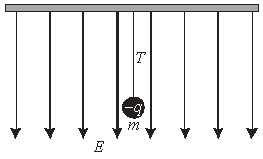
-If m = 1 g, q = 1 C and E = 5000 N/C, the tension T in the string is
A) 5 * 10-3 N
B) 9.81 *10-3 N
C) 4.81 *10-3 N
D) 1.48 *10-2 N
E) 0
A conducting sphere has a net charge of -q and of mass m is suspended from the ceiling by a light string. A uniform electric field E is applied vertical down on the sphere.

-If m = 1 g, q = 1 C and E = 5000 N/C, the tension T in the string is
A) 5 * 10-3 N
B) 9.81 *10-3 N
C) 4.81 *10-3 N
D) 1.48 *10-2 N
E) 0

Unlock Deck
Unlock for access to all 87 flashcards in this deck.
Unlock Deck
k this deck
49
 Three charges Q1, Q2, and Q3, each equal to 6.4 *10-19 C, are in a straight line. The distance between neighboring charges is 60 nm. The magnitude of the electric field at P, which is 80 nm from Q2 on a line at right angles to the line between Q1 and Q3, is
Three charges Q1, Q2, and Q3, each equal to 6.4 *10-19 C, are in a straight line. The distance between neighboring charges is 60 nm. The magnitude of the electric field at P, which is 80 nm from Q2 on a line at right angles to the line between Q1 and Q3, isA) 1.2 * 10-8 N/C
B) 16 N/C
C) 2.0 N/C
D) 1.9 *1010 N/C
E) 1.2 *108 N/C

Unlock Deck
Unlock for access to all 87 flashcards in this deck.
Unlock Deck
k this deck
50
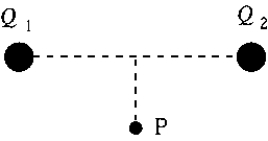 Two charges Q1 and Q2 are 8.0 cm apart. Charge Q1 = 5.0 nC and Q2 = -5.0 nC. The magnitude of the electric field at point P, 3.0 cm from the midpoint of the line joining Q1 and Q2, is
Two charges Q1 and Q2 are 8.0 cm apart. Charge Q1 = 5.0 nC and Q2 = -5.0 nC. The magnitude of the electric field at point P, 3.0 cm from the midpoint of the line joining Q1 and Q2, isA) 2.9 *105 N/C
B) 2.9 * 104 N/C
C) 3.6 * 105 N/C
D) 0.29 kN/C
E) 3.6 * 106 N/C

Unlock Deck
Unlock for access to all 87 flashcards in this deck.
Unlock Deck
k this deck
51
 The electric field at point A is zero. What is charge Q1?
The electric field at point A is zero. What is charge Q1?A) +32 C
B) -32 C
C) The field cannot be zero at A for any value of Q1.
D) +16 C
E) -16 C

Unlock Deck
Unlock for access to all 87 flashcards in this deck.
Unlock Deck
k this deck
52
The direction of the electric field at a point is the same as
A) the force on a neutron placed at that point.
B) the force on a proton placed at that point.
C) the force on an electron placed at that point.
D) the force on a hydrogen molecule placed at that point.
E) None of these is correct.
A) the force on a neutron placed at that point.
B) the force on a proton placed at that point.
C) the force on an electron placed at that point.
D) the force on a hydrogen molecule placed at that point.
E) None of these is correct.

Unlock Deck
Unlock for access to all 87 flashcards in this deck.
Unlock Deck
k this deck
53
An electric field with a magnitude of 6.0 *104 N/C is directed parallel to the positive y axis. A particle with a charge q = 4.8*10-19 C is moving along the x axis with a speed v = 3.0 * 106 m/s. The force on the charge is approximately
A) 8.6*10-8 N perpendicular to the xy plane.
B) 2.9 * 10-14 N in the y direction.
C) 8.6 * 10-8 N in the x direction.
D) zero.
E) 2.9 *10-14 N in the x direction.
A) 8.6*10-8 N perpendicular to the xy plane.
B) 2.9 * 10-14 N in the y direction.
C) 8.6 * 10-8 N in the x direction.
D) zero.
E) 2.9 *10-14 N in the x direction.

Unlock Deck
Unlock for access to all 87 flashcards in this deck.
Unlock Deck
k this deck
54
A particular nucleus of the element plutonium contains 94 protons and 150 neutrons. What is the magnitude of the electric field at a distance of 0.563*10-12 m from the nucleus?
A) 6.81 * 1017 N/C
B) 4.27 * 1017 N/C
C) 2.40 * 105 N/C
D) 3.83 * 105 N/C
E) none of the above
A) 6.81 * 1017 N/C
B) 4.27 * 1017 N/C
C) 2.40 * 105 N/C
D) 3.83 * 105 N/C
E) none of the above

Unlock Deck
Unlock for access to all 87 flashcards in this deck.
Unlock Deck
k this deck
55
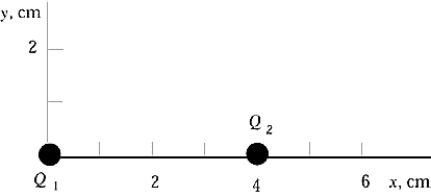 In the diagram, Q1 = 6.0 C and Q2 = -6.0 C. The electric field at point (2, 0) is
In the diagram, Q1 = 6.0 C and Q2 = -6.0 C. The electric field at point (2, 0) isA) in the positive x direction.
B) in the negative x direction.
C) in the positive y direction.
D) in the negative y direction.
E) zero at this point.

Unlock Deck
Unlock for access to all 87 flashcards in this deck.
Unlock Deck
k this deck
56
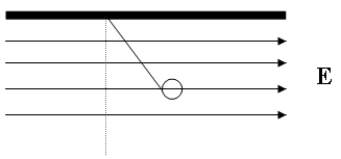 A bob of mass m (m = 0.500 g), and charge magnitude Q (Q = 50.0 C) is held by a massless string in a uniform electric field E. If the bob makes an angle of 10.0 degrees with the vertical, then calculate the magnitude of the electric field E and the sign of the bob charge Q.
A bob of mass m (m = 0.500 g), and charge magnitude Q (Q = 50.0 C) is held by a massless string in a uniform electric field E. If the bob makes an angle of 10.0 degrees with the vertical, then calculate the magnitude of the electric field E and the sign of the bob charge Q.A) 1.73 *101 N/C and Q is positive.
B) 9.81 *101 N/C and Q is negative.
C) 9.81 * 101 N/C and Q is positive.
D) 1.73 *101 N/C and Q is negative.
E) 1.80 *10-1 N/C and Q is positive.

Unlock Deck
Unlock for access to all 87 flashcards in this deck.
Unlock Deck
k this deck
57
Use the picture for the next problem.
A conducting sphere has a net charge of -q and of mass m is suspended from the ceiling by a light string. A uniform electric field E is applied vertical down on the sphere.
-The tension T in the string is ____ the weight mg.
A) less than
B) equal to
C) greater than
D) dependent on the strength of E in relation to
E) insufficient information to tell
A conducting sphere has a net charge of -q and of mass m is suspended from the ceiling by a light string. A uniform electric field E is applied vertical down on the sphere.

-The tension T in the string is ____ the weight mg.
A) less than
B) equal to
C) greater than
D) dependent on the strength of E in relation to
E) insufficient information to tell

Unlock Deck
Unlock for access to all 87 flashcards in this deck.
Unlock Deck
k this deck
58
Two point charges of unknown magnitude and sign are a distance d apart. If the electric field strength is zero at a point between them on the line joining them, you can conclude that
A) the charges are equal in magnitude but opposite in sign.
B) the charges are equal in magnitude and have the same sign.
C) the charges are not necessarily equal in magnitude but have opposite signs.
D) the charges are not necessarily equal in magnitude but have the same sign.
E) there is not enough information to say anything specific about the charges.
A) the charges are equal in magnitude but opposite in sign.
B) the charges are equal in magnitude and have the same sign.
C) the charges are not necessarily equal in magnitude but have opposite signs.
D) the charges are not necessarily equal in magnitude but have the same sign.
E) there is not enough information to say anything specific about the charges.

Unlock Deck
Unlock for access to all 87 flashcards in this deck.
Unlock Deck
k this deck
59
The SI units of electric fields can be expressed as
A) C/m2
B) C/s
C) V · C
D) N
E) V/m
A) C/m2
B) C/s
C) V · C
D) N
E) V/m

Unlock Deck
Unlock for access to all 87 flashcards in this deck.
Unlock Deck
k this deck
60
 Charges Q1 = -q and Q2 = +4q are placed as shown. Of the five positions indicated by the numbered dots, the one at which the electric field
Charges Q1 = -q and Q2 = +4q are placed as shown. Of the five positions indicated by the numbered dots, the one at which the electric field  is zero is
is zero isA) 1
B) 2
C) 3
D) 4
E) 5

Unlock Deck
Unlock for access to all 87 flashcards in this deck.
Unlock Deck
k this deck
61
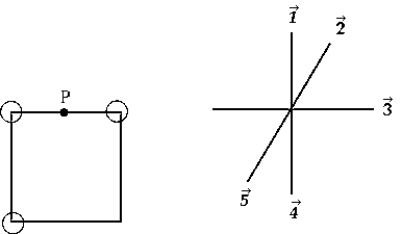 A square has equal positive charges at three of its corners, as shown. The direction of the electric field at point P is
A square has equal positive charges at three of its corners, as shown. The direction of the electric field at point P isA)

B)

C)

D)

E)


Unlock Deck
Unlock for access to all 87 flashcards in this deck.
Unlock Deck
k this deck
62
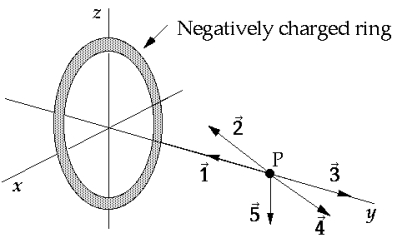 The point P is on the axis of a ring of charge, and all vectors shown lie in the yz plane. The negatively charged ring lies in the xz plane. The vector that correctly represents the direction of the electric field at this point is
The point P is on the axis of a ring of charge, and all vectors shown lie in the yz plane. The negatively charged ring lies in the xz plane. The vector that correctly represents the direction of the electric field at this point isA)

B)

C)

D)

E)


Unlock Deck
Unlock for access to all 87 flashcards in this deck.
Unlock Deck
k this deck
63
Use the picture for the next problem. 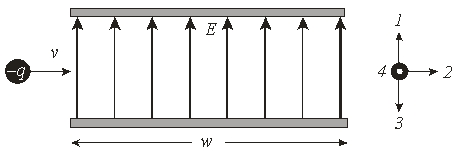 A negatively charged particle moving with speed v enters a region of uniform electric field E.
A negatively charged particle moving with speed v enters a region of uniform electric field E.
-If the charge q = 1 nC, mass m = 1 * 10-14 kg, speed v = 105 m/s, the electric field strength E = 2 *105 V/m, and width, w, of the electric field is 0.2 m, what is the speed of the particle when it emerges from the other side?
A) 1.0 * 105 m/s
B) 4.0* 104 m/s
C) 1.08 *105 m/s
D) 1.4 * 105 m/s
E) 1.8 *105 m/s
 A negatively charged particle moving with speed v enters a region of uniform electric field E.
A negatively charged particle moving with speed v enters a region of uniform electric field E.-If the charge q = 1 nC, mass m = 1 * 10-14 kg, speed v = 105 m/s, the electric field strength E = 2 *105 V/m, and width, w, of the electric field is 0.2 m, what is the speed of the particle when it emerges from the other side?
A) 1.0 * 105 m/s
B) 4.0* 104 m/s
C) 1.08 *105 m/s
D) 1.4 * 105 m/s
E) 1.8 *105 m/s

Unlock Deck
Unlock for access to all 87 flashcards in this deck.
Unlock Deck
k this deck
64
An electron is released from rest in a uniform electric field. If the electric field is 1.25 kN/C, at the end of 20 ns the electron's velocity will be approximately
A) 2.5*10-5 m/s
B) 3.9 * 103 m/s
C) 3.0 * 108 m/s
D) 2.5 * 103 m/s
E) 4.4 *106 m/s
A) 2.5*10-5 m/s
B) 3.9 * 103 m/s
C) 3.0 * 108 m/s
D) 2.5 * 103 m/s
E) 4.4 *106 m/s

Unlock Deck
Unlock for access to all 87 flashcards in this deck.
Unlock Deck
k this deck
65
Which of the following statements about electric field lines is not true?
A) The number of lines leaving a positive charge or entering a negative charge is proportional to the charge.
B) The lines begin on positive charges and end on negative charges.
C) The density of the lines (the number per unit area perpendicular to the lines) is proportional to the magnitude of the field at that point.
D) Electric field lines cross midway between charges that have equal magnitude and sign.
E) The direction of each line indicates the direction that a positively charged particle would move if placed at that point in the electric field.
A) The number of lines leaving a positive charge or entering a negative charge is proportional to the charge.
B) The lines begin on positive charges and end on negative charges.
C) The density of the lines (the number per unit area perpendicular to the lines) is proportional to the magnitude of the field at that point.
D) Electric field lines cross midway between charges that have equal magnitude and sign.
E) The direction of each line indicates the direction that a positively charged particle would move if placed at that point in the electric field.

Unlock Deck
Unlock for access to all 87 flashcards in this deck.
Unlock Deck
k this deck
66
An oil droplet of mass 1.00 *10-14 kg loses an electron while it is in an electric field of 1.00 *106 N/C. The resulting change in the acceleration of the oil droplet is approximately
A) 1.76* 1017 m/s2
B) 16.0 m/s2
C) 1.60 m/s2
D) 1.76 * 1018 m/s2
E) 176 m/s2
A) 1.76* 1017 m/s2
B) 16.0 m/s2
C) 1.60 m/s2
D) 1.76 * 1018 m/s2
E) 176 m/s2

Unlock Deck
Unlock for access to all 87 flashcards in this deck.
Unlock Deck
k this deck
67
An electron is released from rest in a uniform electric field. If the electric field is 3.65 kN/C, at the end of 15 ns the electron's velocity will be approximately
A) 9.6*106 m/s
B) 3.9 * 103 m/s
C) 3.1 *108 m/s
D) 5.5 * 103 m/s
E) 7.4 * 106 m/s
A) 9.6*106 m/s
B) 3.9 * 103 m/s
C) 3.1 *108 m/s
D) 5.5 * 103 m/s
E) 7.4 * 106 m/s

Unlock Deck
Unlock for access to all 87 flashcards in this deck.
Unlock Deck
k this deck
68
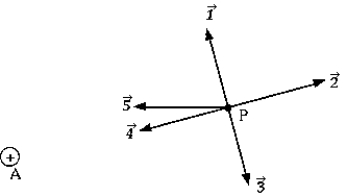 A small positive charge is located at A. The vector that gives the direction of the electric field at point P is
A small positive charge is located at A. The vector that gives the direction of the electric field at point P isA)

B)

C)

D)

E)


Unlock Deck
Unlock for access to all 87 flashcards in this deck.
Unlock Deck
k this deck
69
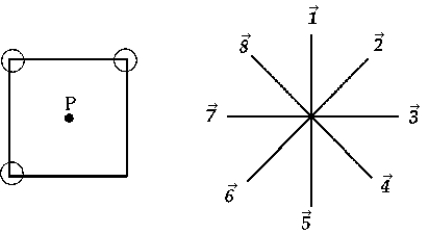 A square has equal positive charges at three of its corners, as shown. The direction of the electric field at point P is
A square has equal positive charges at three of its corners, as shown. The direction of the electric field at point P isA)

B)

C)

D)

E)


Unlock Deck
Unlock for access to all 87 flashcards in this deck.
Unlock Deck
k this deck
70
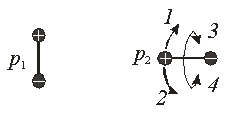 Two electric dipoles, p1 and p2, are arranged as shown. The first dipole is not free to rotate but the second dipole can rotate in any direction. Which way will p2 rotate? The directions represent the following: 1 - clockwise, 2 - counter-clockwise, 3 - rotate about axis of the dipole rolling up, and 4 - rotate about axis of the dipole rolling down.
Two electric dipoles, p1 and p2, are arranged as shown. The first dipole is not free to rotate but the second dipole can rotate in any direction. Which way will p2 rotate? The directions represent the following: 1 - clockwise, 2 - counter-clockwise, 3 - rotate about axis of the dipole rolling up, and 4 - rotate about axis of the dipole rolling down.A) 1
B) 2
C) 3
D) 4
E) None of these is correct.

Unlock Deck
Unlock for access to all 87 flashcards in this deck.
Unlock Deck
k this deck
71
 The figure shows the field lines for two charges. What is the ratio of the top charge to the bottom charge?
The figure shows the field lines for two charges. What is the ratio of the top charge to the bottom charge?A) 1:2
B) -1:2
C) 2:1
D) -2:1
E) 2:-1

Unlock Deck
Unlock for access to all 87 flashcards in this deck.
Unlock Deck
k this deck
72
In a uniform electric field a proton has
A) a constant velocity in the direction of the field.
B) a constant velocity in a direction opposite to that of the field.
C) an approximately constant acceleration the direction of the field.
D) an approximately constant acceleration in a direction opposite to that of the field.
E) an approximately constant acceleration in a direction at right angles to the field.
A) a constant velocity in the direction of the field.
B) a constant velocity in a direction opposite to that of the field.
C) an approximately constant acceleration the direction of the field.
D) an approximately constant acceleration in a direction opposite to that of the field.
E) an approximately constant acceleration in a direction at right angles to the field.

Unlock Deck
Unlock for access to all 87 flashcards in this deck.
Unlock Deck
k this deck
73
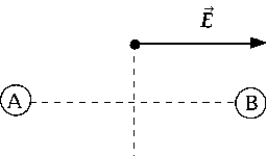 In the figure, the direction of the electric field at a point equidistant from two equally charged bodies A and B is indicated by a vector. The direction of the vector indicates that
In the figure, the direction of the electric field at a point equidistant from two equally charged bodies A and B is indicated by a vector. The direction of the vector indicates thatA) both A and B are positive.
B) both A and B are negative.
C) A is positive and B is negative.
D) B is positive and A is negative.
E) B is negative and A is neutral.

Unlock Deck
Unlock for access to all 87 flashcards in this deck.
Unlock Deck
k this deck
74
Use the picture for the next problem.  A negatively charged particle moving with speed v enters a region of uniform electric field E.
A negatively charged particle moving with speed v enters a region of uniform electric field E.
Using the direction compass on the right, the direction of the force on the charge is
A) 1
B) 2
C) 3
D) 4
E) There is no force on the charge.
 A negatively charged particle moving with speed v enters a region of uniform electric field E.
A negatively charged particle moving with speed v enters a region of uniform electric field E.Using the direction compass on the right, the direction of the force on the charge is
A) 1
B) 2
C) 3
D) 4
E) There is no force on the charge.

Unlock Deck
Unlock for access to all 87 flashcards in this deck.
Unlock Deck
k this deck
75
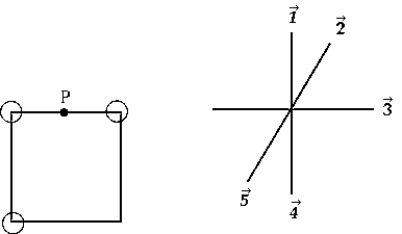 A square has equal positive charges at three of its corners and a negative charge at the third. The direction of the electric field at point P is
A square has equal positive charges at three of its corners and a negative charge at the third. The direction of the electric field at point P isA)

B)

C)

D)

E)


Unlock Deck
Unlock for access to all 87 flashcards in this deck.
Unlock Deck
k this deck
76
Which of the following statements about electric field lines are true?
A) The lines are drawn symmetrically entering or leaving an isolated charge.
B) At large distances from a system of charges, the field lines are equally spaced and radial, as if they came from a single point charge equal to the net charge of the system.
C) Electric field lines begin on positive charges (or at infinity) and end on negative charges (or at infinity).
D) The number of lines leaving a positive charge or entering a negative charge is proportional to the charge.
E) All of these statements are true.
A) The lines are drawn symmetrically entering or leaving an isolated charge.
B) At large distances from a system of charges, the field lines are equally spaced and radial, as if they came from a single point charge equal to the net charge of the system.
C) Electric field lines begin on positive charges (or at infinity) and end on negative charges (or at infinity).
D) The number of lines leaving a positive charge or entering a negative charge is proportional to the charge.
E) All of these statements are true.

Unlock Deck
Unlock for access to all 87 flashcards in this deck.
Unlock Deck
k this deck
77
If nonelectric forces are negligible, a positively charged particle released from rest in a nonuniform electric field
A) moves perpendicular to the field with constant velocity.
B) moves with constant velocity parallel to the field.
C) accelerates in the direction of the field.
D) accelerates perpendicularly to the field.
E) moves only along equipotential lines.
A) moves perpendicular to the field with constant velocity.
B) moves with constant velocity parallel to the field.
C) accelerates in the direction of the field.
D) accelerates perpendicularly to the field.
E) moves only along equipotential lines.

Unlock Deck
Unlock for access to all 87 flashcards in this deck.
Unlock Deck
k this deck
78
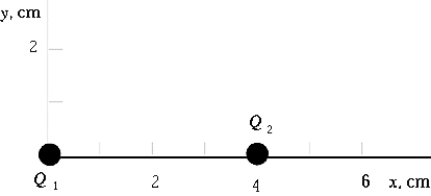 In the diagram, Q1 = 6.0 C and Q2 = -6.0 C. If Q2 has a mass of 2.0 g, a uniform electric field of 1.5 kN/C imposed in the positive y direction would give this particle an acceleration in the y direction of approximately
In the diagram, Q1 = 6.0 C and Q2 = -6.0 C. If Q2 has a mass of 2.0 g, a uniform electric field of 1.5 kN/C imposed in the positive y direction would give this particle an acceleration in the y direction of approximatelyA) zero
B) 9.0 mm/s2
C) 22 cm/s2
D) 4.5 m/s2
E) 7.5 * 105 m/s2

Unlock Deck
Unlock for access to all 87 flashcards in this deck.
Unlock Deck
k this deck
79
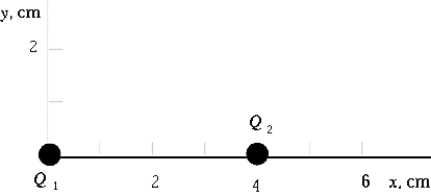 In the diagram, Q1 = 9.0 C and Q2 = -9.0 C. If Q2 has a mass of 3.0 g, a uniform electric field of 1.8 kN/C imposed in the positive y direction would give this particle an acceleration in the y direction of approximately
In the diagram, Q1 = 9.0 C and Q2 = -9.0 C. If Q2 has a mass of 3.0 g, a uniform electric field of 1.8 kN/C imposed in the positive y direction would give this particle an acceleration in the y direction of approximatelyA) zero
B) 5.4 m/s2
C) 6.8 cm/s2
D) 4.5 m/s2
E) 7.5 cm/s2

Unlock Deck
Unlock for access to all 87 flashcards in this deck.
Unlock Deck
k this deck
80
 An electric dipole consists of a positive charge separated from a negative charge of the same magnitude by a small distance. Which, if any, of the diagrams best represents the electric field lines around an electric dipole?
An electric dipole consists of a positive charge separated from a negative charge of the same magnitude by a small distance. Which, if any, of the diagrams best represents the electric field lines around an electric dipole?A) 1
B) 2
C) 3
D) 4
E) None of these is correct.

Unlock Deck
Unlock for access to all 87 flashcards in this deck.
Unlock Deck
k this deck



